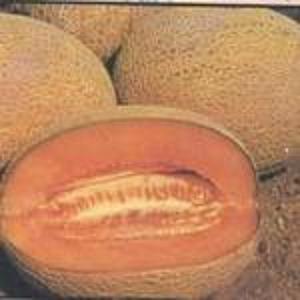Although some watermelon can weigh up to 200 pounds, they’re all big babies. They need to be warm; they don’t like the cold. They need water, but not too much water. They want mulch. They want fertilizer. But homegrown watermelon is worth the extra work. Sugary and succulent, you won’t need to buy candy to satisfy your sweet tooth, at least not until your last melon is gone.
It’s not difficult to grow watermelon; they’re just a little finicky. Follow these easy steps and you should be knee deep in melons by August.
Grow Watermelon: Where?
Watermelon needs warmth. You need to grow watermelon in full sun. Watermelon, including the bush variety, requires ample spacing. Because of the abundant foliage, they need plenty of air circulation as a defense against disease and wilt. Make sure your watermelon patch is near a water source. Carrying water for watermelons is no fun.
Grow Watermelon: Preparing the Soil
Watermelon have moderately deep root systems, so work the soil to a depth of at least 10″. Their preference is light textured soil; sandy, loamy and well drained. Watermelon can tolerate some soil acidity, but grow best when pH levels are 5.5-7.0. Watermelon are voracious feeders, so spade in plenty of manure compost.
Depending on where you live, watermelon is the perfect candidate for “black plastic mulch.” Here’s a link to an article on how to install it:
http://www.ehow.com/how_4423025_use-black-plastic-mulch-transplanting.html
Black plastic mulch not only warms the soil, it helps retain heat and aids in weed control. It also reduces evaporation of water, therefore reducing fertilizer leaching. And, if ascetics matter, it keeps your watermelon cleaner.
Many gardeners who grow watermelon, with black plastic mulch or without, install a drip irrigation system or a soaker hose. If you’re using plastic mulch, put the watering source UNDERNEATH the plastic.
Grow Watermelon: Seed Selection
If this is your first attempt to grow watermelon, choose an “open pollinated” seed. Seedless watermelon, require the grower to plant another type of watermelon for fertilization. Grow only one variety of watermelon if you intend to save some seeds to plant next year.
Over the last 30 years, there have been substantial advances in producing strains of watermelon that are disease resistant. Check the back of the seed envelope for that information.
Watermelon can be round or oblong in shape. Skin color ranges from light green to almost black. It can be striped, marbled, solid. My personal favorite is Moon and Stars. Watermelon flesh can be deep red, bright red, pink, pink-red, orange and yellow. They can be as small as three pounds, like the “ice box” variety or a “personal” size. The Charleston Grays, that oblong beauty you see most often in the grocery store, can get up to 35 pounds. Those 200 pounders that win prizes at the county fair are Carolina Cross.
Grow Watermelon: Inside or Out?
Back in the day, it was recommended not to grow watermelon seedlings inside. What that really meant was that watermelon DO NOT like to have their roots disturbed. So, starting your melons inside is perfectly okay providing you use a peat pot that can go directly in the ground, or a 3″ pot that you can carefully tip the seedling out of. Plant your seeds ¾”-1″ deep. Cover lightly and water. Keep the soil moist but not wet.
Large seedlings don’t transplant well. Time your seed starting so that seedlings are only two to four weeks old when you move them to the garden. Here’s a link to a government website that will tell you when the last frost date is for your area. http://www.ncdc.noaa.gov/oa/ncdc.html
Since watermelon prefer soil that is at least 65 degrees, it will probably take a few more weeks after the last frost for the soil to warm up enough to set your seedlings out. Most bush varieties will mature in 80-90 days, but the regular, long vining melons need 90-100 days to reach optimum size and sweetness. Old timers who grow watermelon year in and year out, caution that you should allow several more days for watermelon to ripen than what is printed on the seed envelope.
When you transplant seedlings, plant at the same depth as they were in the pot. In other words, don’t bury your seedlings up to their little leaves or you’ll kill them. If you do choose to transplant your watermelon, adjust your harvest time table. Many times transplanted watermelons will ripen 10-14 days earlier than expected. Once your little guys are in the ground, use a common starter fertilizer to promote growth.
If you opt to plant seeds directly into the garden, plant your watermelon seeds 1″-1½” deep, and the seeds 4″-6″ apart. After germination, thin the seedlings so there is 10″-12″ between plants. It’s a good idea to keep about 10′ between rows.
If you’re going to grow watermelon using the hill method, make sure your hill is at least 2′ in diameter and at least one foot deep. Keep the hills 5′-10′ apart, depending on the variety you have chosen. Plant three or four seeds per hill, 1″-1½” deep. Once little green sprouts are up, thin the seedlings, keeping the strongest looking two.
Grow Watermelon: Baby Your Babies
There are almost as many methods to get from sprout to melon as there are growers, but most of the experts agree on a few things you need to do to grow watermelon:
- Feed the baby. Watermelon needs a fertilizer high in nitrogen to encourage growth. From the time it sprouts until the flowers form, fertilize every three weeks. Once the buds appear, switch to a fertilizer that is higher in phosphorous and potassium.
- Watermelon LOVE water. Keep the soil moist at all times.
- Keep weeds away from your babies. Weeds fight your watermelon for water and fertilizer, and the weeds usually win.
- Many gardeners who grow watermelon, tend to prefer liquid fertilizers and foliar (through the leaves) feeding.
- Some gardeners like to grow watermelon under a white, floating cloth. It helps retain the heat and provides protection from cold spring breezes and bugs. However, as soon as the blossoms appear, remove the cloth so the bees and butterflies can pollinate.
Grow Watermelon: Where Have All the Flowers Gone?
The first flowers will be male and pollen bearing. There are both female and male flowers on each watermelon vine, but it’s only the females that will bear fruit. Watering close to the roots will keep your flowers dry and ready for fertilization. It takes a while for the melons to blossom, but when they do, it’ll be about 35-40 days until harvest.
Grow Watermelon: From Sprout to Harvest
Watering your vines is a tricky balancing act. It is generally recommended that you maintain a strict water regiment from the time the fruit begins to form until it is half grown. Some of the pros feel that too much watering too close to harvest not only reduces the sugar content but causes the watermelon to have a hollow center.
Once the vines are established and the fruit has grown to half size, back off on the watering, unless you get a dry spell. Mulching will really help retain moisture.
Grow Watermelon: Due Diligence
You’re not the only one in your garden who likes watermelon. You may have to battle a variety of pests and diseases to help your watermelon grow healthy and strong. Common enemies of the watermelon are: squash vine bore, cucumber beetles, aphids, wire worms, cut worms, pickleworms, red spider mites, nematodes and the leaf miners.
An ounce of prevention is worth a pound of cure. If you notice any pests or diseases, it’s easier to treat them sooner rather than later. The best pest and disease deterrent having healthy soil, weeding, pruning and proper spacing.
If you’re concerned about the cucumber beetle attacks, try planting some radishes around the base of the vines. Cucumber beetles do not like radishes.
Here’s a link to an article that has recipes to make your own pesticides: http://www.associatedcontent.com/article/35917/how_to_make_your_own_pesticide.html?cat=7
Besides the bugs, there are several diseases that can destroy your watermelon patch: fusarium wilt, anthracnose, alternaria leaf spot, gummy stem blight, watermelon mosaic virus and blossom end rot.
Keeping your vines dry with plenty of air circulation will help prevent some of these diseases.
Cornell University developed a recipe for a fungicide that you can make in your own kitchen: Mix 3 tablespoons of VEGETABLE oil and 1 teaspoon of baking soda into a gallon of water. Spray on the infected areas every three or four days until irradicated.
Grow Watermelon: Is it Ripe?
When you grow watermelon in your garden, you’ll know when it’s ripe. If you think those melons you get at the grocery store taste great on a hot day, wait until you bust into one of YOUR vine ripened babies. Commercially grown watermelon is picked before it’s ripe. Watermelon does not continue to ripen and sweeten once it’s off the vine.
How can you tell if your watermelon is ready to pick?
- There are little green tendrils that curl around on the stem where it’s connected to the watermelon. When those tendrils turn brown and dry up, your watermelon is ready for harvesting.
- The stem, next to the fruit, starts to dry out and shrivel.
- The skin color of the watermelon goes dull, like matte paint.
- It becomes difficult to penetrate the skin with your thumb nail.
- The “ground spot” turns creamy or yellow NOT white or pale green.
- The melon will seem very heavy for its size.
- The ground spot feels slightly bumpy and the skin feels leathery.
- Your watermelon has stopped growing.
Grow Watermelon: Reap the Rewards
Many times when you grow watermelon, you end up with a surplus. What are you going to do with all that watermelon? The first several you’ll probably want to eat ice cold. Thirst quenching, there is nothing better on a hot August afternoon. Then take a few to your neighbors. They will welcome you with open arms. Giving away watermelon is a lot easier (and more fun) then giving away zucchini.
You can chunk some watermelon and freeze it for later. The texture will change, but it’s perfect to use in smoothies. Watermelon makes wonderful granita and sorbet. Ask your family members if they have recipes for watermelon rind pickles, or relishes, jellies and preserves.
Save some watermelon seeds to plant next season. After washing them, lay the seeds on paper towels to dry before storing in an envelope.
Another great reason to grow watermelon is that you can eat the seeds! Try this simple recipe: Wash and dry the seeds. In a heavy skillet over medium heat, toast the seeds dry (with no oil) for several minutes, stirring constantly. Dissolve 3 tablespoons of salt into one cup of water. Pour over seeds – be careful because it might spatter. Continue simmering and stirring until all the water has evaporated and the seeds look powdery from the salt. Eat watermelon seeds like you eat sunflower seeds; crack the shell and eat the meat inside.




